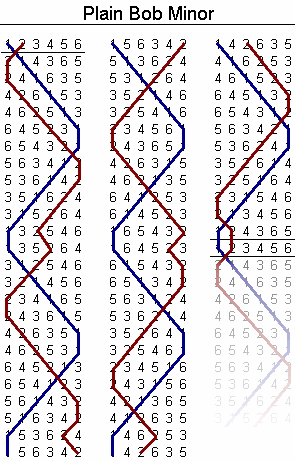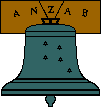
Change ringing is the art of ringing a set of tuned bells in a tightly controlled manner to produce precise variations in their successive striking sequences, known as "changes". This can be by method ringing in which the ringers commit to memory the rules for generating each change, or by call changes, where the ringers are instructed how to generate each change by instructions from a conductor. This creates a form of bell music which cannot be discerned as a conventional melody, but is a series of mathematical sequences.
Campanology is the scientific and musical study of bells. It encompasses the technology of bells – how they are founded, tuned and rung – as well as the history, methods, and traditions of bellringing as an art.
Method ringing is a form of change ringing in which the ringers commit to memory the rules for generating each change of sequence, and pairs of bells are affected. This creates a form of bell music which is continually changing, but which cannot be discerned as a conventional melody. It is a way of sounding continually changing mathematical permutations.

Russian Orthodox bell ringing has a history starting from the baptism of Rus in 988 and plays an important role in the traditions of the Russian Orthodox Church.

St Peter Mancroft is a parish church in the Church of England, in the centre of Norwich, Norfolk. After the two cathedrals, it is the largest church in Norwich. It was originally established by the then Earl of East Anglia, Ralph de Gael between 1066 and 1075. It was later rebuilt, between 1430 and 1455. It stands on a slightly elevated position, next to the market place.
The Oxford University Society of Change Ringers, founded in 1872, is the official society dedicated to change ringing in Oxford University. Its objects are to promote the art of change ringing in the university and to ring for Sunday services in Oxford during full term.

The Manchester Universities Guild of Change Ringers is a bell ringing guild based in Greater Manchester, whose home tower is the Sacred Trinity in Salford. Most of the members are, or have been in the past, students attending the universities and colleges in Manchester and Salford. The guild is a member of the Northern Universities Association.
The Ancient Society of College Youths (ASCY) is a change ringing society, founded in 1637 and based in the City of London. The society played a leading role in the early development of change ringing, and today, it provides ringers for important events at St Paul's Cathedral and Westminster Abbey. Although it is a non-territorial association, its importance is recognised through having four representatives on the Central Council of Church Bell Ringers.

Change ringing software encompasses the several different types of software in use today in connection with change ringing.
Grandsire is one of the standard change ringing methods, which are methods of ringing church bells or handbells using a series of mathematical permutations rather than using a melody. The grandsire method is usually rung on an odd number of bells: Grandsire doubles is rung on five working bells, grandsire triples on seven, grandsire caters on nine and grandsire cinques on eleven. Like all odd-bell methods, where there are sufficient bells, it is normally rung with a "cover" bell, which stays in the last position in each row to add musicality.
Call change ringing is a branch of the art of change ringing, in which a group of English-style full-circle bell ringers are instructed continually to create different sequences, or changes, of the bells' striking order. Each command from the leader or "conductor" of the ringing results in a new sequence of sounding the bells. Each sequence is repeated until the next command or "call".
The North American Guild of Change Ringers (NAGCR) was founded in 1972 after the hanging of a ring of bells in the Washington National Cathedral in Washington, D.C., United States, in 1964. The NAGCR has now grown and expanded to 52 bell towers across the United States and Canada as well as one mini-ring and 9 hand-bell groups with more than 500 members residing in North America. This organization performs the art of change ringing or method ringing, a form of campanology, in the towers and on hand-bells. This art uses mathematical sequences and patterns to change bell orders to carry out these sequences. Change ringing began in England in the 17th century.
Fabian Stedman (1640–1713) was an English author and a leading figure in the early history of campanology, particularly in the field of method ringing. He had a key role in publishing two books Tintinnalogia and Campanalogia which are the first two publications on the subject. He is also regarded as being a pioneer in the branch of mathematics known as Group theory.

The University of Bristol Society of Change Ringers (UBSCR) is a change ringing society. UBSCR is associated with the University of Bristol and is affiliated to Bristol SU. UBSCR was established in 1943 and has rung bells at St Michael on the Mount Without since 1944. Since 1950 there have been over 700 peals rung for the society. UBSCR is also affiliated to the Central Council of Church Bell Ringers and sends two representatives to its AGM.
John Holt was a leading change ringer and noted composer of peals on English full circle bells in the 18th century, and is described as a composer "..holding a position which is unique in the history of change ringing".
The Central Council of Church Bell Ringers (CCCBR) is an organisation founded in 1891 which represents ringers of church bells in the English style.

The Australian and New Zealand Association of Bellringers, known as ANZAB, is the organisation responsible for the promotion of English-style "full circle ringing" – namely change ringing and method ringing in bell towers with a peal of bells – across Australia and New Zealand.
Albert John Pitman is regarded by change ringing campanologists as a remarkable and versatile composer of peals in bell ringing methods. Described as 'perhaps the greatest of all time' in the Central Council of Church Bell Ringers biography of him, An Unassuming Genius, he was an extraordinary talent in the field of peal composition.

The Suffolk Guild of Ringers for the Diocese of St Edmundsbury and Ipswich is a society and charity supporting the bell ringers and rings of bells in the Diocese of St Edmundsbury and Ipswich who practice the art of change ringing. The Guild was established on 2 April 1923 at Ipswich and covers over 200 rings of bells in the county of Suffolk in the area that falls within the diocese boundary.
Campanology is the scientific and musical study of bells. It encompasses the technology of bells – how they are cast, tuned, and rung – as well as the history, methods, and traditions of bellringing as an art. Articles related to campanology include:










